Our traditional challah recipe creates two gorgeously braided loaves perfect for a Jewish holiday.
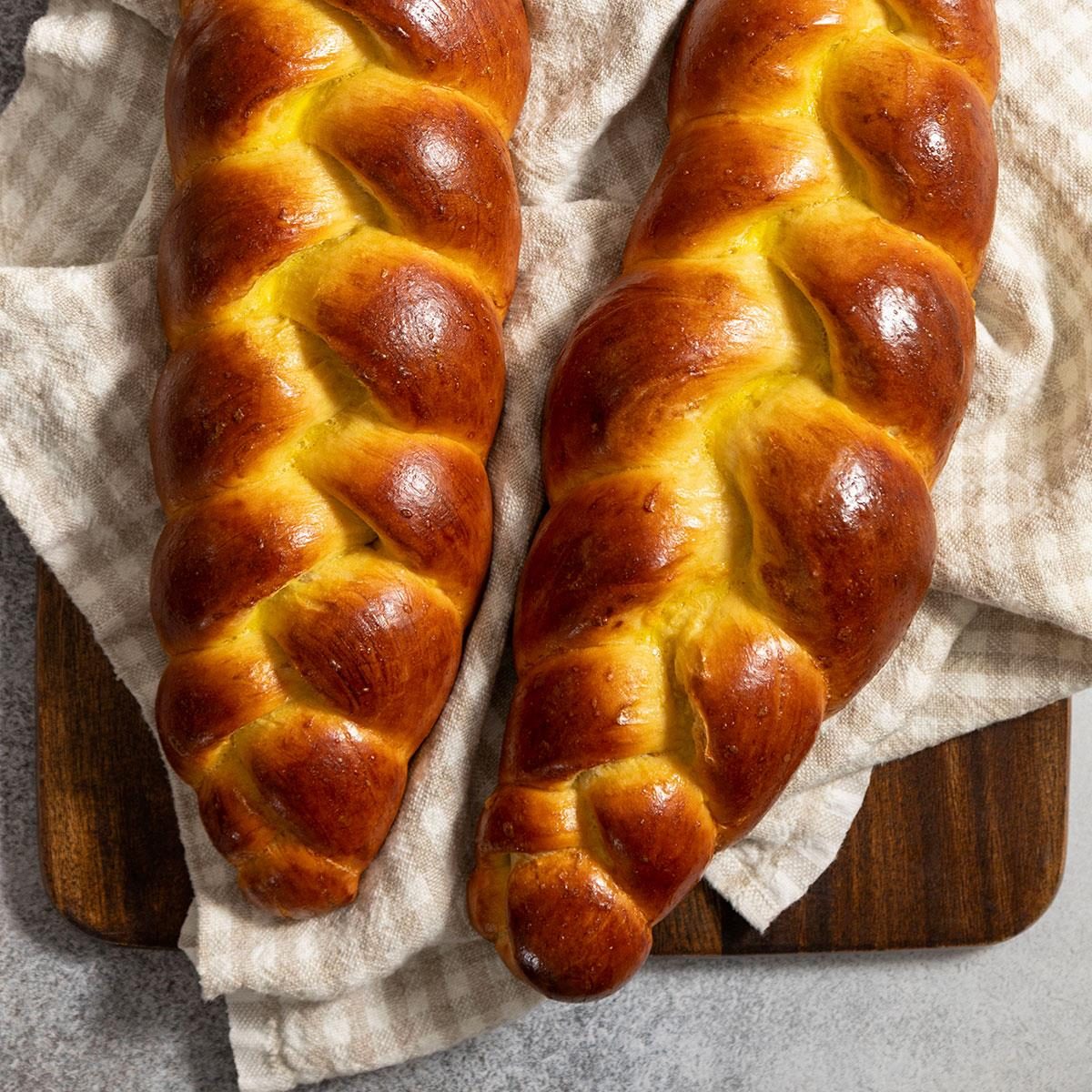
Challah

Challah is a symbolic centerpiece at the heart of a Jewish holiday spread. The braided bread is eaten at many celebrations, including Shabbat and Rosh Hashanah. Our challah recipe creates two thick loaves with the traditional braided shape, a soft inner crumb and a dark brown, pliable crust.
Challah bread is so beloved that it’s become a bakery standard, but don’t go off buying a loaf just yet—it’s worth making this gorgeous bread in your own kitchen. Once you pull two beautifully braided breads out of the oven, with the aroma of yeast perfuming the air, you’ll know it was worth the effort.
What is challah bread?
Challah is a loaf of braided bread made with yeast, eggs, oil, sugar, water, flour and salt. It’s typically pale yellow in color because so many eggs are used, and it has a rich flavor. Some challah recipes call for raisins, honey or seeds. It all depends on the celebration and your preferences.
Culturally, challah is an important part of the Jewish Shabbat (or Sabbath), as well as many holidays and social gatherings like weddings or funerals. “Challah” refers to the mitzvah (a blessing or good deed) of separating out a portion of the dough before you begin braiding as a contribution to the kohen (priest). This commandment is called the hafrashat challah. Braided loaves can symbolize love or represent other aspects of Jewish tradition.
Three-strand challah is common, with the strands said to represent truth, peace and justice. But you’ll also see more intricately braided challahs with four, five and even six strands. Elongated loaves of challah are eaten year-round, while round challahs are traditional for Rosh Hashanah (the start of the Jewish new year) because they represent continuity and the cyclical nature of the world.
How do you pronounce challah?
Wondering how to say challah? English speakers say haa-luh (no ch sound). It’s a Hebrew word that starts with a letter there isn’t an equivalent for in English—the “ch” represents that letter. It’s the same reason you might see the winter holiday Hanukkah written as “Chanukah.”
Challah Ingredients
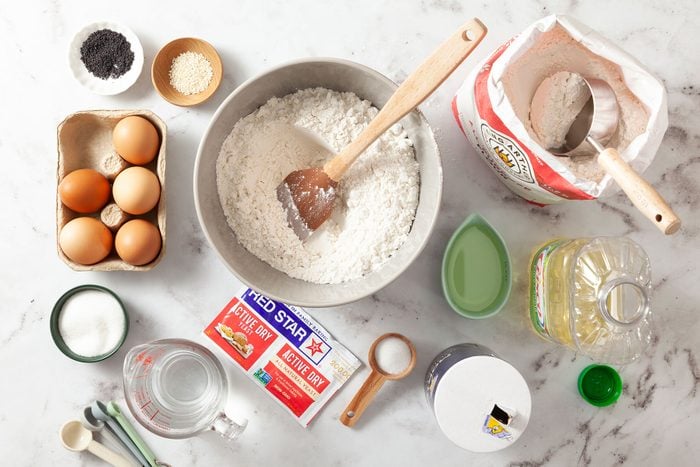
- Active dry yeast: You’ll need two packets of active dry yeast for this challah bread recipe. Make sure the package is labeled active dry yeast instead of instant yeast.
- Warm water: The temperature should be between 110° to 115°F to proof the yeast.
- Eggs: We use four eggs to add richness and strength to the challah. Another egg is used for an egg wash before you bake the bread.
- All-purpose flour: The high gluten content in all-purpose flour builds strong, structured ropes that create a clean braid. You can also use bread flour here instead.
- Sugar: Sugar brings a bit of sweetness.
- Canola oil: The oil adds moisture and tenderness to this dairy-free dough.
- Sesame seeds or poppy seeds: Sprinkle these on top to symbolize the manna that fell from heaven after the exodus from Egypt. These are an optional topping, but we love their symbolism and the texture they add.
Directions
Step 1: Proof the yeast
As with any yeasted bread, the first step is to proof the yeast to make sure the yeast is still alive and ready to create a light and airy loaf. To proof the yeast, dissolve two packets of yeast in warm water. Don’t use water that’s above 115° because it will kill the yeast. Give the mixture a stir and let it sit for about five minutes. When it gets frothy, it’s ready to use.
Editor’s Tip: If the yeast mixture doesn’t froth and bubble, throw it out and start again with new yeast. Make sure your yeast hasn’t expired and that your water is the right temperature.
Step 2: Create the dough
Put the oil, sugar, salt, eggs and 4 cups of flour into a bowl, and beat until smooth. You can also do this in a stand mixer on medium speed.
Stir in enough of the remaining flour to form a firm dough.
Step 3: Knead the dough
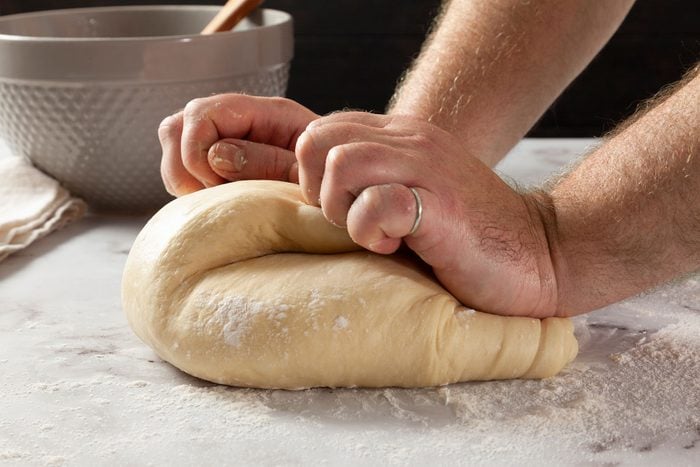
Turn your dough out onto a floured worktop and knead until it’s smooth and elastic, six to eight minutes. You’ll know your dough is kneaded enough when you’re able to stretch a piece of dough between your fingers and it gets very thin without breaking (this is the windowpane test). If it tears, the dough needs to be worked more.
Step 4: Let it rise
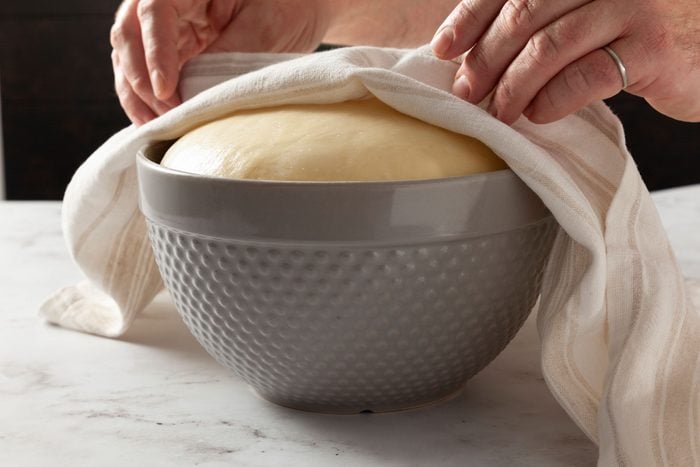
Place the dough in a greased bowl, turning once to grease the top. Cover the bowl with a damp tea towel or storage wrap and let it rise in a warm place until it doubles it size. Because there’s a lot of dough, it’ll take about 60 minutes for the bread to rise.
Step 5: Form the ropes
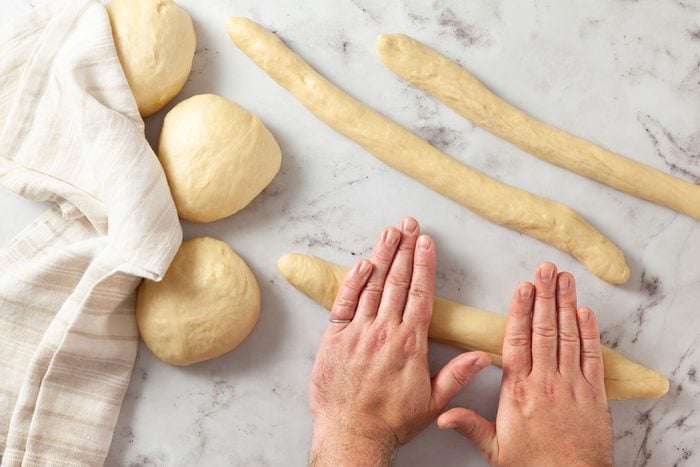
After the dough has doubled in size, punch it down (in other words, press some of the air out of it with your knuckles). Turn the dough out onto a lightly floured worktop and divide it in half. Divide each half into thirds. You can do this by weight if you’d like; just weigh the dough and divide it by six.
Roll each piece into a 15-inch rope. Place three ropes next to each other on a greased baking sheet and pinch them together at the top. Do the same with the three remaining ropes. You should now have two sets of three-stranded ropes pinched and ready to braid.
Step 6: How to braid challah bread
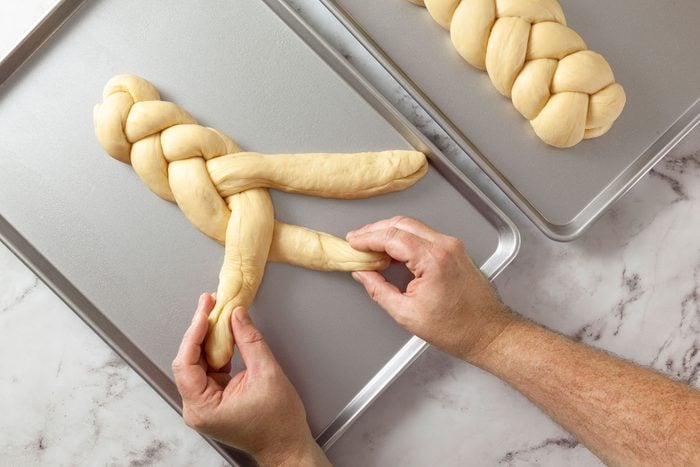
Place one loaf (a set of three rope strands) on a greased baking sheet. Braid the strands with a basic braiding technique: Take the strand on the right, cross it over the middle strand, and place down it between the middle and left strands.
Next, take the strand on the left, cross it over the new middle strand, and place it down between the middle strand and new right strand. Follow this pattern until the entire strands are braided.
Pinch the ends to seal and tuck them under. Repeat the process with the second set of ropes.
Step 7: Proof again and bake
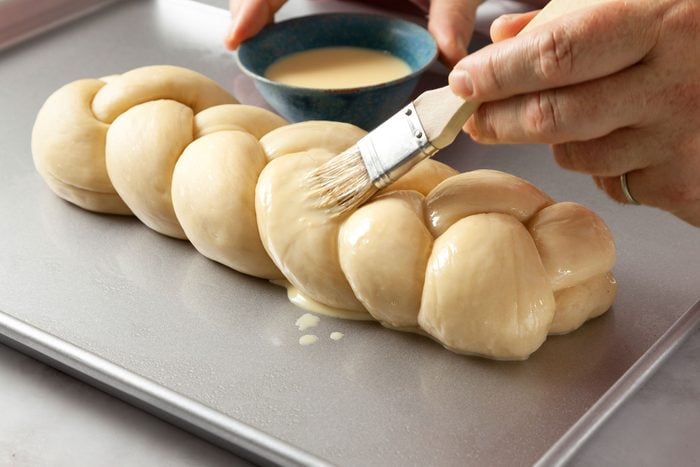
Cover the loaves and let them rise until they double in size. It’ll take about an hour.
Preheat your oven to 350ºF.
Once the loaves have grown, create your egg wash by whisking together the egg and cold water. Brush the mixture over the loaves with a pastry brush, then sprinkle with sesame or poppy seeds, if you’re using them. Bake until the bread is golden brown, 30 to 40 minutes. (Here’s a trick to know the bread is done.)
Remove the challah loaves from the sheet pan and place them on a wire rack to cool to room temperature before serving.
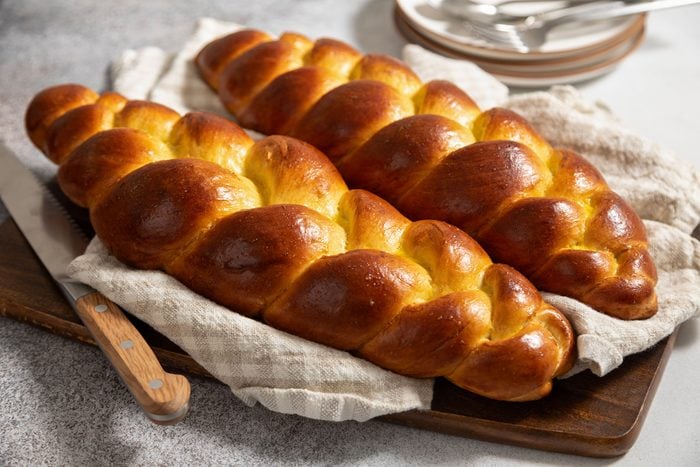
Recipe Variations
- Add raisins or other dried fruit: Raisins symbolize sweetness and happiness, so include them when celebrating joyous holidays. Knead in 2 cups of golden raisins that have been rehydrated in 1 cup of boiling water for five minutes then drained and patted dry.
- Grate in zest: Add citrus zest to pump up the flavor of this challah recipe. Make sure you don’t grate any of the bitter pith into the dough. Here are a few easy ways to zest to avoid that.
- Sprinkle in baking spices: Add sweet cinnamon, fragrant cardamom or other warming spices to the dough. You can use the spices in addition to nuts, orange zest and raisins. Add it all!
How to Store Challah
Cool the challah to room temperature, then store the challah in a bag or bread box to keep it fresh. Since it’s scratch-made, it will go stale faster than the loaves you find at the store. If you can’t finish it within a few days, you can freeze the bread and thaw it later, when you need it for a holiday or gathering.
Challah Tips
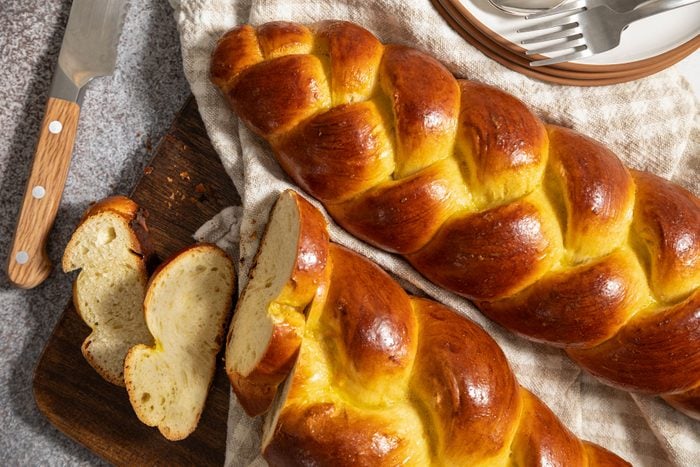
What can you make with leftover challah?
If you haven’t tried French toast or bread pudding made with a loaf of challah, you’re in for a treat! The egg in the challah gives these dishes a rich, custardy texture. Try chocolate challah French toast or challah bread pudding. You can also use a loaf of challah in place of brioche bread in recipes like our best French toast.
For a simpler option, slice the challah just like a regular loaf of bread and use it for toast or a sandwich. We love a lightly toasted slice of challah with cream cheese, a dollop of fresh jam, or a drizzle of honey.
How do you make challah with more braids?
This recipe makes a braided loaf with three strands, but you can create more intricate braids with four or six strands. To make a simple four-strand braid, follow the instructions for our celebration braid.
There are different methods for making a loaf with six strands. The first, and simplest, is to layer two separate three-strand braids on top of one another, as we do in our braided egg bread. To braid the six strands, follow our step-by-step instructions (with pictures!) in our honey challah recipe.
How do you make a round challah?
To create a round loaf, first make the braid and then wrap it around itself in a coil and tuck the end under. It’s a good idea to make the individual ropes a little longer so the braid is long enough to shape into a full coil.
What’s the difference between brioche and challah bread?
The difference between brioche and challah bread is that brioche contains dairy. Challah does not, so, following the rules of kosher cooking, it can be eaten with a meat meal. Challah uses oil as one of the main enriching ingredients (as well as eggs and sugar), while brioche uses butter.
Challah
Ingredients
- 2 packages (1/4 ounce each) active dry yeast
- 1 cup warm water (110° to 115°)
- 1/2 cup canola oil
- 1/3 cup sugar
- 1 tablespoon salt
- 4 large eggs, room temperature
- 6 to 6-1/2 cups all-purpose flour
- TOPPING:
- 1 large egg
- 1 teaspoon cold water
- 1 tablespoon sesame or poppy seeds, optional
Directions
- In a large bowl, dissolve yeast in warm water. Add the oil, sugar, salt, eggs and 4 cups flour. Beat until smooth. Stir in enough remaining flour to form a firm dough. Turn out onto a floured surface; knead until smooth and elastic, 6-8 minutes. Place in a greased bowl, turning once to grease the top. Cover and let rise in a warm place until doubled, about 1 hour.
- Punch dough down. Turn out onto a lightly floured surface; divide in half. Divide each portion into thirds. Shape each piece into a 15-in. rope.
- Place 3 ropes on a greased baking sheet and braid; pinch ends to seal and tuck under. Repeat with remaining dough. Cover and let rise until doubled, about 1 hour.
- Preheat oven to 350°. Beat egg and cold water; brush over braids. Sprinkle with sesame or poppy seeds if desired. Bake until golden brown, 30-40 minutes. Remove to wire racks to cool.
Nutrition Facts
1 piece: 139 calories, 5g fat (1g saturated fat), 29mg cholesterol, 233mg sodium, 20g carbohydrate (2g sugars, 1g fiber), 4g protein.





















